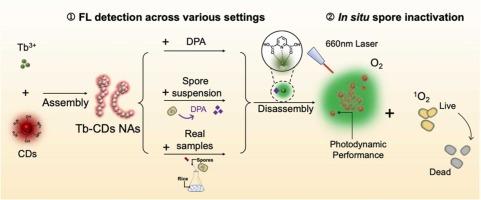Versatile Tb3+–carbon-dot nanoplatform for fluorescence detection and in situ inactivation of bacterial spores
IF 8
1区 化学
Q1 CHEMISTRY, ANALYTICAL
引用次数: 0
Abstract
Pathogenic bacterial spores pose a considerable threat to human health due to their ability to survive extreme environmental conditions. Thus, sensitive detection and efficient inactivation of these spores are essential for preventing disease transmission. However, most existing studies have predominantly concentrated on detection alone. Herein, we developed a versatile nanoplatform that integrates sensitive bacterial spore sensing and in situ spore inactivation capabilities by assembling terbium ions (Tb3+) with photosensitizing carbon dots (CDs), referred to as Tb-CDs nanoassemblies (NAs). By leveraging the unique optical properties of CDs and Tb3+ ions, along with the antenna effect of lanthanides, Tb-CDs NAs demonstrated highly sensitive visual detection of the key bacterial spore biomarker, pyridinedicarboxylic acid (DPA), achieving a low detection limit of 0.68 μM and excellent selectivity. Additionally, Tb-CDs NAs exhibited practical sensing capabilities in various environments, including spore suspensions and real samples, while monitoring bacterial spore germination. Further studies confirmed that the DPA-triggered disassembly of Tb-CDs NAs led to the release of CDs, enabling higher affinity for spores and in situ inactivation through singlet oxygen generation. This work underscores the potential of CDs-based assemblies for simultaneous pathogen detection and inactivation, providing promising tools for preventing bacterial spread and contamination.

用于荧光检测和原位灭活细菌孢子的多功能Tb3+ -碳点纳米平台
致病菌孢子具有在极端环境条件下生存的能力,对人类健康构成相当大的威胁。因此,灵敏的检测和有效的灭活这些孢子对于预防疾病传播至关重要。然而,大多数现有的研究主要集中在检测上。在此,我们开发了一种多功能纳米平台,通过将铽离子(Tb3+)与光敏碳点(CDs)组装在一起,将敏感的细菌孢子传感和原位孢子失活能力集成在一起,称为Tb-CDs纳米组件(NAs)。利用CDs和Tb3+离子独特的光学特性,以及镧系元素的天线效应,Tb-CDs NAs对细菌孢子关键生物标志物吡啶二羧酸(pyridinedicarboxylic acid, DPA)的视觉检测具有高灵敏度,检测限低至0.68 μM,具有良好的选择性。此外,Tb-CDs NAs在各种环境中表现出实际的传感能力,包括孢子悬浮液和真实样品,同时监测细菌孢子的萌发。进一步的研究证实,dpa触发的Tb-CDs NAs的分解导致CDs的释放,使其对孢子具有更高的亲和力,并通过单线态氧产生原位失活。这项工作强调了基于cd的组件在同时检测和灭活病原体方面的潜力,为防止细菌传播和污染提供了有前途的工具。
本文章由计算机程序翻译,如有差异,请以英文原文为准。
求助全文
约1分钟内获得全文
求助全文
来源期刊

Sensors and Actuators B: Chemical
工程技术-电化学
CiteScore
14.60
自引率
11.90%
发文量
1776
审稿时长
3.2 months
期刊介绍:
Sensors & Actuators, B: Chemical is an international journal focused on the research and development of chemical transducers. It covers chemical sensors and biosensors, chemical actuators, and analytical microsystems. The journal is interdisciplinary, aiming to publish original works showcasing substantial advancements beyond the current state of the art in these fields, with practical applicability to solving meaningful analytical problems. Review articles are accepted by invitation from an Editor of the journal.
 求助内容:
求助内容: 应助结果提醒方式:
应助结果提醒方式:


